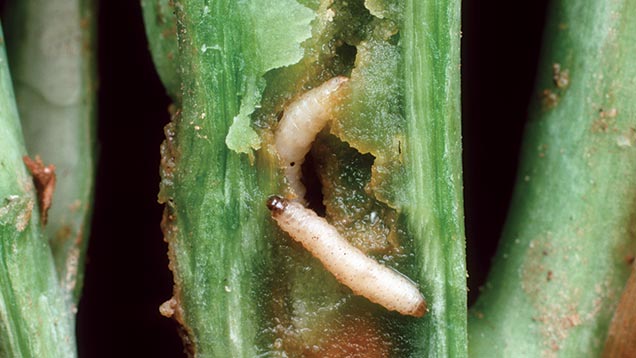Oilseed rape yields threatened by beetle damage
 (c) Nigel Catlin/Alamy
(c) Nigel Catlin/Alamy Oilseed rape growers are being urged to reassess the yield potential of their crops with large numbers of cabbage stem flea beetle larvae being found in plants.
Last autumn saw beetle numbers swell in areas of eastern England and the damage from their larvae could leave crops open to other pest damage and lodging.
See also: Pesticide ban blamed for fall in OSR plantings
Ryan Hudson, agronomist with distribution group Farmacy, explains that growers in the beetle hotspot areas are seeing some fields “riddled” with the larvae.
“They could do a lot of damage – arguably more than the adults because we cannot control them now and I think we will find out the true extent this season,” he explains.
This is the first season for growing oilseed rape following the European Union ban on neonicotinoid insecticide seed dressing, which has led to a sharp rise in beetle damage.
There is little growers can do now as the only option of tackling the larvae is an autumn pyrethroid spray, so they must now focus on stimulating growth, according to Mr Hudson.
“We’ve got the root structure, but with the pest damage we’re going to need to rebuild the green leaf area with early nitrogen applications,” he says.
Kerb deadline
There is just over two weeks to apply the widely used oilseed rape herbicide Kerb (propyzamide) ahead of the product cut-off date on 31 January.
David Roberts, agronomist at Kerb manufacturer Dow AgroScience, estimates 75% of growers have applied Kerb to their oilseed rape crops.
“It is a crucial herbicide for controlling blackgrass and brings a huge benefit across the rotation, which farmers can’t afford to miss,” he says.
After the end of January those growers who haven’t applied Kerb may consider the carbetamide-based Crawler, which can be applied until the end of February.
Mr Hudson explains keeping other pests at bay to allow the crop to regrow the new leaves in early spring will be vital.
He says growers need to monitor slug and pigeon damage as the combination of the two can strip healthy crops, and leave open canopies where weeds can thrive.
Independent entomologist Alan Dewar agrees that the hangover from beetle attacks last autumn could still have the potential to reduce yields.
He says growers who are seeing more than five larvae a plant could see a dip in yield. He adds the large numbers could carry over into next season.
Meanwhile, Sam Cook of Rothamsted Research says the damage can be severe in some crops as the larvae tunnels into the petiole and eats it from the inside out.
“They can cause loss of plant vigour, which could cause particular problems in areas of low density,” she says.
She also points out the plants can be more susceptible to lodging and be more exposed to fungal infection.

